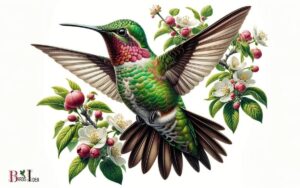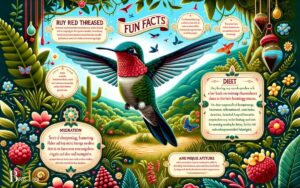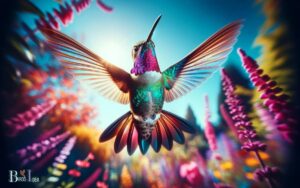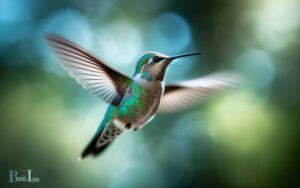What Type of Bugs Do Hummingbirds Eat? Gnats, Mosquitoes!
Hummingbirds primarily eat nectar from flowers but also consume small insects and bugs such as gnats, mosquitoes, fruit flies, spiders, and aphids to fulfill their nutritional needs, particularly for protein.
Hummingbirds are widely recognized for their affinity for nectar, which provides the quick energy they need for their high metabolism and energy-demanding flight. However, nectar alone doesn’t provide all the necessary nutrients.
Here’s what they consume in terms of bugs:
The consumption of these bugs not only contributes to the hummingbirds’ protein intake but also provides essential fats, vitamins, and minerals that are not found in nectar.
While nectar remains a staple for hummingbirds, the ingestion of various bugs is crucial for their dietary balance and overall health.
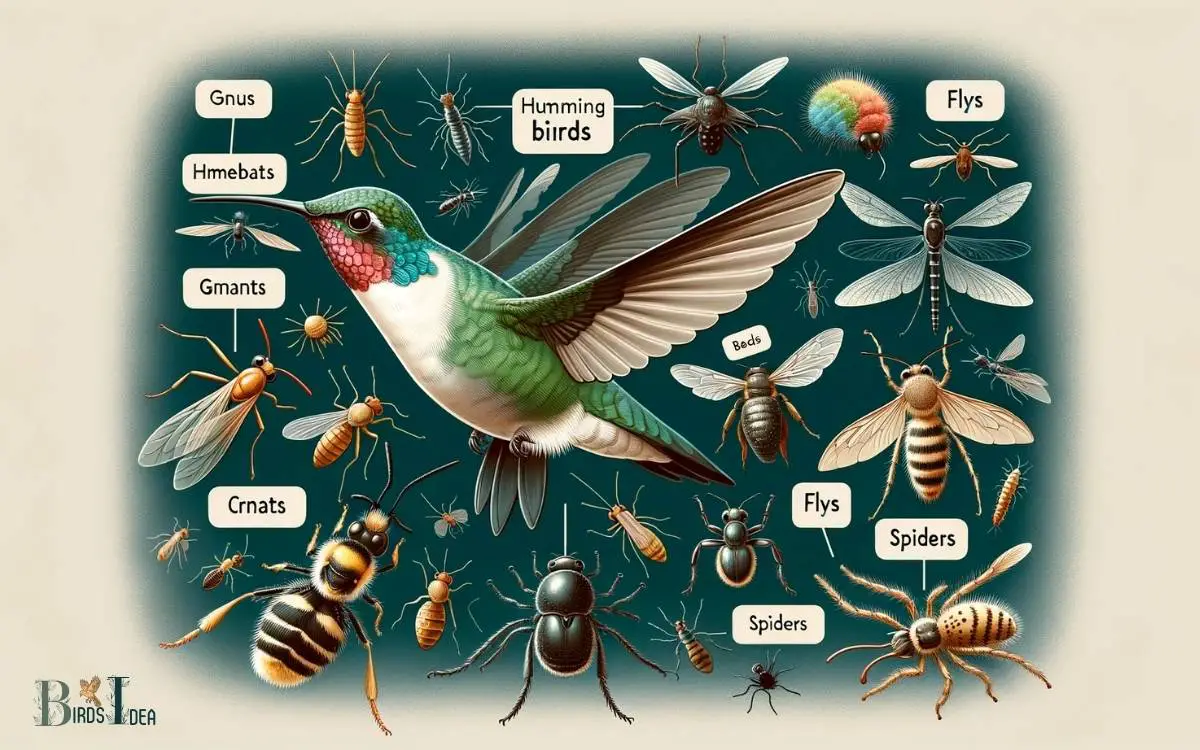
Key Takeaway
Ants and Ant Larvae
Hummingbirds supplement their diet by consuming ants and ant larvae, providing essential protein and nutrients for their survival and energy needs.
These tiny birds are known to be opportunistic feeders, and while nectar from flowers is their primary energy source, they also rely on insects for crucial nutrients. Ants and ant larvae are particularly attractive to hummingbirds due to their high protein content.
Hummingbirds have been observed using their long, specialized bills to extract ants from their nests or simply picking them off of plants.
The consumption of ants and ant larvae not only offers vital nutrients but also aids in controlling ant populations around their habitat.
This demonstrates the resourcefulness of hummingbirds in diversifying their diet to meet their nutritional requirements.
Aphids and Scale Insects
While foraging for food, hummingbirds can also consume aphids and scale insects as a supplementary source of nutrients. These small insects are often found on the underside of leaves and stems of plants.
The table below provides a comparison of aphids and scale insects, two common types of pests that hummingbirds may feed on.
| Feature | Aphids | Scale Insects |
|---|---|---|
| Size | Small | Small to tiny |
| Movement | Active | Mostly immobile |
| Damage to plants | Suck plant juices | Pierce and feed on sap |
| Protection | Secretes honeydew | Produces a waxy shell |
| Control | Ladybugs, lacewings, etc. | Natural predators |
Hummingbirds play a role in controlling these pests, helping to maintain a balance in the ecosystem while obtaining additional nutrients in their diet.
Flies and Gnats
Flies and gnats are among the small flying insects that form a significant part of a hummingbird’s diet. These insects provide essential dietary protein for the hummingbirds, enabling them to sustain their high metabolic rates.
Gardeners can naturally attract hummingbirds by cultivating plants that attract flies and gnats, providing a food source for these fascinating birds.
Small Flying Insects
Small flying insects, such as flies and gnats, are a crucial component of the hummingbird’s diet due to their high protein content and easy accessibility in mid-air.
These tiny insects provide essential nutrients that power the hummingbird’s high-energy lifestyle.
Consider the following:
- Hummingbirds tirelessly dart through the air, their delicate bodies fueled by the protein-rich sustenance of flies and gnats.
- These insects serve as a vital source of nourishment, enabling hummingbirds to sustain their rapid wingbeats and agile maneuvers.
- The efficient metabolism of these small flying insects allows hummingbirds to thrive and maintain their active foraging behavior.
This concludes the exploration of small flying insects as an essential part of the hummingbird’s diet.
Dietary Protein Source
The consumption of flies and gnats by hummingbirds as a dietary protein source is vital for sustaining their high-energy lifestyle and agile foraging behavior.
Hummingbirds rely on these small flying insects to meet their protein requirements, especially during the breeding season when their nutritional needs are heightened.
These insects provide essential nutrients that enable hummingbirds to maintain their rapid metabolism and fuel their hovering and darting flight patterns.
Below is a table summarizing the nutritional content of flies and gnats as a dietary protein source for hummingbirds:
| Nutrient | Flies | Gnats |
|---|---|---|
| Protein | High | Moderate to High |
| Fat | Low | Low |
| Carbohydrates | Low | Low |
| Vitamins | B vitamins | B vitamins |
| Minerals | Iron, Zinc | Iron, Zinc |
This table highlights the high protein content of flies and gnats, making them a crucial dietary component for hummingbirds.
Attracting Hummingbirds Naturally
Hummingbirds rely on flies and gnats as a natural means of attracting them to gardens and yards, providing an essential protein source for their high-energy lifestyle. Attracting these tiny, iridescent creatures to your outdoor space can be a rewarding experience.
Consider the following to evoke an emotional response in the audience:
- Beauty: Imagine the joy of witnessing these enchanting birds flitting around your garden, sipping nectar while also preying on flies and gnats.
- Connection to Nature: Creating a habitat that naturally draws hummingbirds fosters a deeper connection to the natural world, allowing for peaceful moments of observation and reflection.
- Contribution to Conservation: By providing a welcoming environment for hummingbirds, you are contributing to the preservation of these remarkable creatures and the ecosystems they inhabit.
Beetles and Weevils
Beetles and weevils are important sources of protein for hummingbirds as they forage for food. These insects are rich in nutrients and provide essential sustenance for hummingbirds, especially during breeding and molting seasons.
Hummingbirds are known to consume a variety of beetle and weevil species, ranging from small leaf beetles to larger weevils. They catch these insects in mid-air or pluck them from leaves and flowers with impressive agility and precision.
The high protein content found in beetles and weevils supports the energetic demands of hummingbirds, enabling them to maintain their rapid metabolism and sustain their active lifestyle.
Additionally, the consumption of these insects contributes to the overall health and vitality of hummingbirds, making them an indispensable part of their diet.
As hummingbirds hunt for beetles and weevils, they also rely on other insects such as mosquitoes and midges for sustenance.
These tiny creatures play a crucial role in providing the necessary nourishment for hummingbirds, contributing to their survival and well-being.
Mosquitoes and Midges
An important component of the hummingbird diet includes mosquitoes and midges, which provide essential nourishment for their survival and well-being.
Mosquitoes and midges are not only pesky insects to humans but also carry diseases, so by consuming them, hummingbirds help control their population and reduce the risk of diseases.
This behavior showcases the mutually beneficial relationship between hummingbirds and humans, as the birds contribute to natural pest control.
Furthermore, the consumption of mosquitoes and midges helps to maintain ecological balance by controlling the population of these insects, ultimately benefiting the overall ecosystem.
Understanding the role of hummingbirds in controlling disease-carrying insects like mosquitoes can foster a greater appreciation for these tiny, yet vital, avian creatures.
Moths and Caterpillars
Moths and caterpillars play a significant role in the diet of hummingbirds. Moths are often hunted by hummingbirds at night when they are most active, while caterpillars are sought after during the day, especially when they are found on plants.
These insects are among the primary prey that hummingbirds rely on to meet their nutritional needs.
Moths at Night
Hummingbirds are known to consume a variety of insects, including moths and caterpillars, especially during the nighttime hours.
This behavior is fascinating for several reasons:
- Predator vs. Prey: The nighttime hunt for moths and caterpillars showcases the hummingbird’s remarkable predatory skills as it darts and hovers to catch its prey in the dark.
- Survival Instinct: For the hummingbird, consuming moths and caterpillars is not just about a meal, it’s about survival. These insects provide essential nutrients and energy to sustain the hummingbird through the night.
- Balancing Act: The delicate balance between the hummingbird and its nocturnal prey highlights the intricate interdependence of various species in the ecosystem, underscoring the marvels of nature’s design.
Caterpillars on Plants
Caterpillars on plants serve as a crucial food source for hummingbirds, providing essential nutrients for their survival and energy needs.
Hummingbirds are known to feed on various species of caterpillars, particularly those found on plants and trees.
These caterpillars are rich in protein and fats, which are vital for the hummingbirds’ high metabolic rate and energy demands.
The consumption of caterpillars also provides essential nutrients for breeding females and growing chicks.
| Caterpillar Species | Preferred Plants |
|---|---|
| Tomato Hornworm | Tomato plants |
| Monarch | Milkweed |
| Eastern Tent | Apple trees |
| Cabbage White | Cabbage plants |
| Luna Moth | Walnut trees |
This table highlights some specific caterpillar species and their preferred host plants, showcasing the diverse sources of food that caterpillars on plants can provide for hummingbirds.
Hummingbirds’ Primary Insect Prey
The consumption of various insect species, particularly those found on plants and trees, plays a crucial role in the diet of hummingbirds, providing essential nutrients for their high metabolic rate and energy demands.
Hummingbirds primarily feed on moths and caterpillars, which are rich sources of protein and fat.
This diet is essential for their survival, especially during the breeding season when they require extra energy for nest building, mating, and raising their young.
The availability of these insects directly impacts the health and reproductive success of hummingbirds.
Without an adequate supply of moths and caterpillars, hummingbird populations could decline, affecting the delicate balance of ecosystems and diminishing the joy these enchanting creatures bring to people who admire them in their natural habitats.
Spiders and Spider Eggs
Among the myriad insects that hummingbirds consume, they also feed on a variety of spiders and their eggs.
Spiders and their eggs are an important protein source for hummingbirds, particularly during the breeding season when they require increased energy.
Hummingbirds are known to pick spiders off their webs or capture them in flight. While some spiders may seem large in comparison to the size of a hummingbird, they are still a viable source of nutrition.
Additionally, hummingbirds have been observed consuming spider eggs, which are high in fat and provide a concentrated source of energy.
This behavior demonstrates the adaptability of hummingbirds in seeking out diverse sources of nutrition to meet their energetic demands.
Conclusion
Hummingbirds have a diverse diet that includes ants, aphids, flies, beetles, mosquitoes, moths, and spiders.
Their ability to consume a wide variety of bugs reflects their adaptability and resourcefulness in finding food.
This reminds us of the importance of being open-minded and flexible in our approach to challenges, as we can find solutions in unexpected places.
Just as hummingbirds find sustenance in various insects, we can find opportunities for growth and success in unexpected circumstances.

